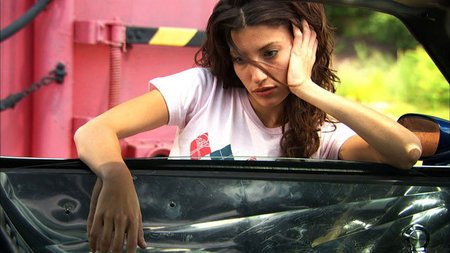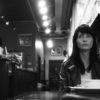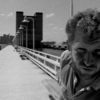
From Both Sides
Written by Ellen Mills | Posted by: Anonymous
AD Calvo will let you borrow a great scary story to tell
around the campfire this summer, and you’ll find it in his latest feature film,
The Other Side of The Tracks. It’s the story of a man haunted by visions
after the tragic death of his girlfriend 10 years earlier. His best friend
tries to help him move on, while a mysterious new woman captures his attention.
Calvo says he has been a horror movie fan since childhood,
so the genre was a natural choice for his first feature. The film was shot in
Connecticut during the summer of 2007. Television fans will recognize lead
actors Brendan Fehr from Roswell, Chad Lindberg from Supernatural,
and Tania Raymonde from Lost.
Calvo recently spoke to NewEnglandFilm.com about the making
of the film.
Ellen Mills: How would you describe the film?
AD Calvo: This film is a ghost story. It’s a
supernatural mystery but it is also a romantic fantasy. There’s definitely a
love story. I wanted to transcend that bucket of gore stereotype. It borrows
from different genres and that’s what makes it unique.
EM: Where did the idea come from?
Calvo: Believe it or not I knew it would be
low-budget film, so I wove the story around a couple of locations I had access
to. I’m a big fan of ghost stories — that’s my thing. There are some horror
elements but no blood or slashers. I’m inspired by M. Night Shyamalan and James
Mangold and Hitchcock, among others.
EM: Can you tell me how all the elements of the
film came together?
Calvo: An early version of the script was covered
by Baldwin Entertainment Group. They did the film Ray. Karen Baldwin
was really elemental in casting the film. It being a small film, we did
whirlwind casting right up to the last minute.
EM: How did you come to their attention? Do you
have an agent?
Calvo: No, no agent. A good friend of mine is a
Holy Cross graduate and knew Karen from school.
EM: So, good old networking.
Calvo: Yes, definitely. It took time to build on
long-term relationships and a long time of building relationships.
EM: What was the budget for the film?
Chad Lindberg takes the wheel.
[Click to enlarge]
Calvo: Well, I’m not allowed to discuss the
budget. It’s a SAG modified low-budget film. We’re showing the film to
distributors right now. I can say, and you can quote me on this, like all
independent films we made it for a lot less than is humanly possible.
EM: How did you finance the film?
Calvo: I was one of the investors. You do what you
have to do. It’s important to believe in yourself and I found that it was
helpful to tell other investors that I was invested too. Through another
long-term contact we were able to bring in a law firm and that was a key
element. We used Pullman & Conley, one of the largest firms in Connecticut and
very arts oriented.
EM: What did they do for you?
Calvo: They helped structure the LLC and the
investment contracts. They helped with all the actor and location agreements.
EM: What was the actual production like?
Calvo: We shot the film in 20 days with a six-day
workweek. It was a non-union shoot. We did bring in a director of photography
and a production designer from LA who were union. We told the union about it.
So, it was 20 grueling days. Fourteen hour days and very hot, if you remember
last summer.
EM: Were there any bumps along the road, or should
I say the tracks [since a key scene involves train tracks], during the shoot?
Calvo: There’s always a few bumps. Our biggest
challenge was that our hero car, a 1979 Camaro, caught on fire during one of the
flashback scenes. That was scary, but no one was hurt. After we brushed off
the dust of the fire extinguisher, we were able to push it down hills to get
shots and added the engine sound in postproduction. We were frantic trying to
open the hood, all these flames shot up in the air. But, two days later the car
was running again. It had a leaky fuel filter.
The flashback scene we were shooting at that particular
railroad crossing luckily had a hill right beside it, so we could use that to
get the shots we needed. The week before, we’d been shooting at another
railroad crossing, and it was completely flat. Whether it’s a car or a location
they play a major role in the film. They are almost another character in the
film.
EM: What was the atmosphere on the set?
Calvo: We had a wonderful, healthy set. Everyone
got along great. That just transpired to us being able to make the day and get
the work done. We used lots of PAs from local colleges, and they were really
helpful.
EM: Since you were the writer of the film as well,
did you allow improvisation on the set?
Calvo: I allow for lots of improvisation. A line
of dialog I write sitting at a screen can be interpreted differently by actors.
The beat in a scene and the flow of dialog can sometimes be done better by the
actor.
EM: What kind of preparation do you do with the
actors?
Calvo: We would block out the scene. Actors are
all different; they required my time in different ways. Some wanted to meet in
their trailers before the day began and others didn’t need that. We had a
spectrum of different personalities and talent. On set we would block out the
scene and run it through it a couple of times. Then they would light the scene
and we would go off and come back and shoot it.
EM: You will be coming to the Woods Hole Film
Festival with the film in July. Has the film been in other festivals?
Calvo: Yes, mostly regional festivals. At the Kent
Film Festival we won the audience award and at the Connecticut Film Festival we
won for best cinematography and best soundtrack. Also, at the Florida Music
Festival in Orlando, we were a “spotlight film.”
EM: Will you be attending Woods Hole with the
film?
Calvo: Yes, I will be at the festival.
EM: How have audiences responded to the film?
Calvo: Believe it or not, the version we screened
at Kent and Connecticut was still 106 minutes. Dialog makes it rough to cut
down. I edited it down to 92 minutes. We handed out surveys and those let me
pinpoint areas I needed to work on. I watch a lot of French and Asian films and
they are slower to start, they take their time. In America, we have shorter
attention spans. So, I worked on act one of the film and picked up the pace. I
also improved the scoring.
EM: Is it hard to edit the film when you are so
invested in it?
Calvo: It was hard at first. It was hard to edit
and be the director because you worry about bias. You really need time away
from the film and feedback. No one person or group can cut a film right out of
the gate. I showed the film to test audiences and continued to work the film
and make it better. On the other hand, I didn’t want to change for change’s
sake. It takes a while to boil down info and find the comments you hear from
more than one person. It’s about getting to the point where you have consistent
feedback.
EM: When will you feel it is done?
Calvo: When we send the release cut to the
distributor. So it’s not done until that point. I go back and say, “Oh, why
didn’t I cut that?” There’s a law of diminishing returns though. You have to
move on at some point.
EM: Let’s go back a little bit — how did you
become interested in filmmaking?
Calvo: Back in late 70’s I played around with an
8mm camera. Lots of changes occurred in my life when I was 10 and I kind of
forgot that passion. I went to college for computer science and I worked in
software for 16 years. I never loved it but I got really good at it.
Then I came across a website called triggerstreet.com that
was started by Kevin Spacey. I thought, “Maybe I should try this for awhile,” so
I made three narrative shorts and three documentary shorts. I made a series of
shorts about a sculptor named Daniel Edwards, and those got an extraordinary
number of hits on triggerstreet and YouTube. Even in software I did the stuff
that was visually oriented, the user interface.
EM: How do you edit?
Calvo: With the shorts I used Sony Vegas. It’s
terrific — very intuitive. For the feature I used Final Cut Pro Studio. It
seemed to handle the longer format a little better. A lot of people think, “I’m
working with these tools, it will come out better.” It’s not about the tools;
it’s about what you do with the tools. It’s really about the lighting, the
frame, the lens and the composition.
EM: How did you learn filmmaking?
Calvo: I’m self-taught, I didn’t go to film
school. I read a lot of books, and I’m a big film fan. I watch a lot
of films. Unfortunately, I now watch films more objectively, I miss the
escape of just losing myself. That happens less.
EM: And you’ve always enjoyed the horror genre?
Calvo: Going back to the time of playing with the
8mm cameras, I watched lots of zombie films and horror films. Then they went to
slasher films and I lost interest. I like films that deal with the afterlife
and spiritualism. I like the ghost stories. The Other Side of the Tracks
is one of the few ghost stories shot in daylight. I kind of like that. It’s
not a scare you kind of film, it has a haunting quality.
EM: What do you think of the finished film?
Calvo: I’m pleased with the film. But I’m
very self-critical. I’m amazed that we did it. Could I make a better one now?
Yes. You have to be patient. Filmmakers go through a transformation.
Sometimes someone makes a film, it’s their first film and it just blows you
away. The film turned out a little differently than I originally conceived but
that’s the creative process. There’re moments of serendipity that you have to
be open to.
EM: What are your hopes for the film?
Calvo: That we find a good distributor.
EM: You wrote, directed and edited The Other
Side of the Tracks, would you do that again?
Calvo: Good question. Stories are told by three
people. It was important to me the first time to immerse myself in the
process. I was happy I was able to move through those three positions. I enjoy
those three things, [and] I would like to continue to wear those three hats.
Editing was the most intensive. The directing was the thing I felt most at home
with. The writing was very similar to software — you and the computer are
making things happen. The editing was the most time consuming. It was with me
for four months.
EM: What are your future plans?
Calvo: I’ll be directing a film for Baldwin
Entertainment called Irrefutable. We’re shooting later this fall. I’m
revising the script now. I also have another script called House of Dust
that I wrote. I would like to shoot that next.
For more information about AD Calvo and The Other Side
Of the Tracks, visit
www.goodnightfilm.com. See the trailer
here. For details about the Woods Hole Film Festival:
www.woodsholefilmfestival.org.










